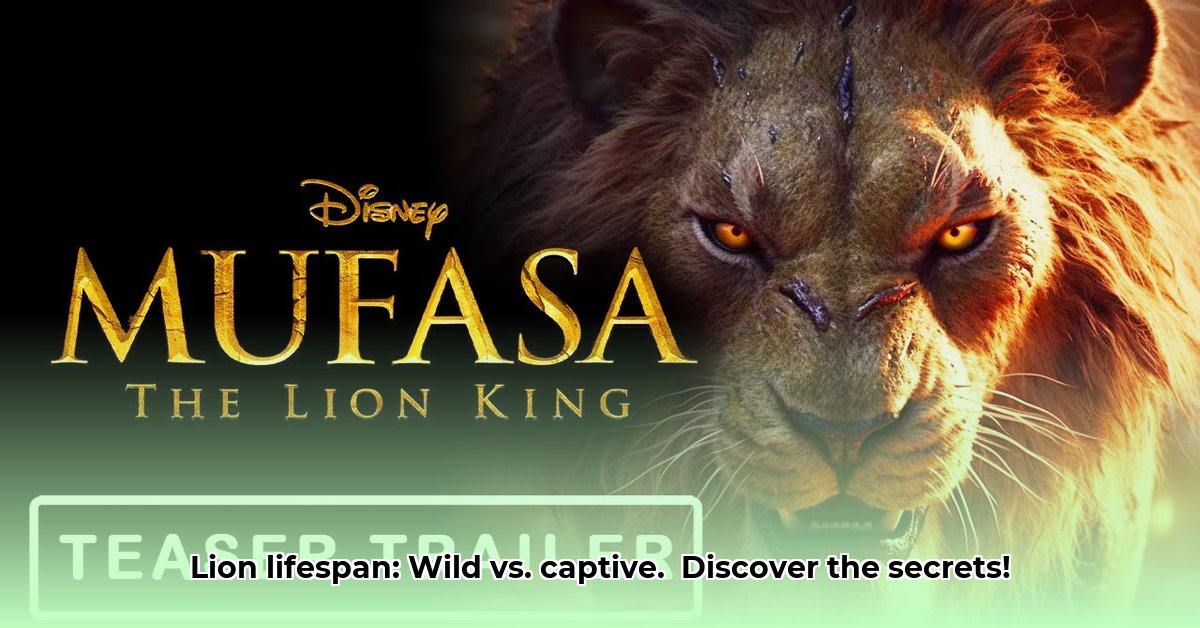Ever wondered how long a lion actually lives? It’s not as straightforward as you might think! A lion’s lifespan depends a lot on whether it’s living in the wild or in a zoo, and even on whether it’s male or female. This article explores the amazing world of lion longevity, explaining why some lions live much longer than others. We’ll look at how things like food availability, fighting other lions, and even humans impact how long these magnificent animals survive. We’ll also discover why zoo lions often live longer, and what we can learn from this to help protect wild lions. Get ready to dive into the secrets of lion lifespans, from the dangers of the African savanna to the comforts of a zoo enclosure, and learn what we can do so these kings and queens of the jungle continue to thrive for years to come.
Unveiling Lion Lifespan Dynamics
How long a lion lives depends heavily on whether it roams wild or enjoys the comforts of a zoo. It’s a fascinating question with a surprisingly complex answer, one that unveils the challenges these magnificent creatures face. Let’s investigate lion longevity and survival rates.
Wild Lion Longevity: Survival on the Savanna
Life as a wild lion is far from easy, significantly impacting their average survival rate. For male lions in their natural habitat, the average lifespan is approximately 8 to 12 years. This relatively short life expectancy results from a number of factors. Male lions frequently face off in intense battles for dominance, and injuries sustained in these fights can be fatal. Starvation is a constant concern, especially during droughts or when prey animals are scarce. Perhaps the biggest threat of all is human-wildlife conflict. Imagine a young male lion, forcefully kicked out of his pride to fend for himself.
He’s vulnerable, constantly facing off against older, more experienced rivals vying for territory. He’s also at risk from human activities, which sadly include being caught in snares, eating poisoned baits left out by farmers protecting livestock, or being hunted by people retaliating for attacked livestock. It’s a constant struggle for survival, impacting wild lion populations and their social dynamics, making lion conservation efforts more critical than ever.
Female lions, on the other hand, tend to live a bit longer with improved chances of survival– around 10 to 15 years. Living within the protective structure of a pride offers important advantages like efficient hunting strategies. Teamwork during hunts improves their chances of success, providing more consistent access to food. The pride also acts as a safety net, providing support in raising cubs and defense against predators. Even so, they still face many of the same threats as their male counterparts.
Notably, a lion named Ram lived to be 16 years old in the Gir sanctuary tourism zone, demonstrating that survival to older ages is possible in the wild under favorable conditions. However, such cases are exceptions rather than the rule.
Captive Lion Longevity: A Safer Existence
The picture changes considerably for lions living in captivity. Safe from the ever-present dangers of the wild, these majestic felines enjoy considerably longer lives, with access to veterinary treatment when needed. In zoos and sanctuaries, male lions can live up to 16 to 20 years, and females often reach an impressive 25 years or more. This dramatic difference is attributed to consistent access to high-quality food, regular veterinary check-ups, and the absence of natural predators or human conflict.
Zenda, a lioness at the Philadelphia Zoo, lived to be 25 years old, highlighting the potential for longevity in captivity. Arjun, who lived at the Animal Rescue Center in India, reached an even more remarkable age, estimated to be between 26 and 29 years old. These examples underscore the profound impact of a secure and well-managed environment.
However, a long life in captivity is not without its potential drawbacks. One concern is the reduced genetic diversity within captive breeding programs, possibly affecting their health or longevity in the long run. There’s also always the potential for age-related illnesses to gradually take their toll. This raises an important question: how can we optimize captive environments for health longevity?
Factors Influencing Lion Lifespan: A Deep Dive
Several factors intertwine to determine a lion’s lifespan, making it a complex and dynamic equation. Genetics undeniably play a part; some lions simply have a predisposition to live longer than others. The environment also plays a crucial role. Abundant prey means better nutrition, therefore a greater chance for a long and healthy life. The presence or absence of diseases, like canine distemper and feline immunodeficiency virus (FIV), can significantly impact overall health and thus, longevity.
Habitat quality is another significant environmental factor. Lions in areas with plentiful prey and access to clean water are more likely to thrive than those in degraded habitats facing scarcity. Climate change also plays a role, with droughts and other extreme weather events impacting prey availability and increasing competition for resources.
A lion’s position within its pride’s social hierarchy significantly influences their life experiences. Females, benefiting from the cooperative hunting and the protection that the pride offers them, naturally tend to live longer than their male counterparts. Their life isn’t easy, but the structure of the pride offers a form of support that the solitary males lack. Do social dynamics enhance survival among these species?
Ultimately, though, human activities represent the most serious threat to lions’ longevity, far outweighing the impact of any natural factors. These threats are becoming some of the biggest factors. What measures are needed to reduce human impacts?
Conservation Efforts: Protecting Lions for Future Generations
Understanding the lifespan variations between wild and captive lions highlights the critical need for effective conservation strategies, aiming for the preservation of African lions. We must proactively work to minimize the conflicts between humans and lions. This involves improving anti-poaching measures, working with local communities to prevent retaliatory killings, and preserving their natural habitats. These efforts require a multi-pronged approach and the commitment of various stakeholders.
Organizations like the World Wildlife Fund (WWF) and Panthera are at the forefront of lion conservation, working to protect their habitats, reduce human-wildlife conflict, and combat poaching. Community-based conservation programs empower local communities to protect lions and benefit from their presence through tourism and other economic opportunities.
Continued research is essential for improving lion health and wellness. Tracking lion populations, studying age-related diseases, and investigating the genetic factors influencing their longevity are all crucial steps in building a full understanding of what keeps them alive for longer. Conservation work is an ongoing endeavor, and new discoveries may further refine our understanding and improve our conservation efforts.
Taking Action: Supporting Lion Conservation
We can all contribute meaningfully to lion conservation to protect endangered species:
- Support conservation organizations: Donate to reputable organizations working tirelessly to protect lions and their habitats.
- Advocate for stronger anti-poaching laws: Contact your elected officials, urging them to enact and enforce stricter laws to combat poaching.
- Educate yourself and others: Learn about the threats facing lions, and share this crucial information with your family and friends.
- Support ethical wildlife tourism: Choose tours that prioritize animal welfare and support sustainable tourism practices, ensuring that money spent directly benefits the animals and their environment.
- Reduce your carbon footprint: Make small changes in your daily life to reduce your environmental impact, collectively making a significant difference.
The question of how long a lion can live isn’t just about numbers; it’s a reflection of our responsibility towards these magnificent creatures and the delicate balance of the ecosystems they inhabit. Their future relies on our collective efforts. How much can sustainable tourism boost their survival?
Enhancing Captive Lion Lifespan and Quality of Life
Key Takeaways:
- Female lions generally outlive males, both in the wild and in captivity.
- Captive lions typically live longer than their wild counterparts due to reduced predation and access to veterinary care.
- A significant number of captive-bred lion cubs die before reaching two years of age (40-75%). The reasons for this are often unknown, highlighting a critical need for improved captive breeding practices.
- Skull abnormalities are far more prevalent in captive lions than in wild lions.
- Human-wildlife conflict is a major threat to wild lion populations.
Wild vs. Captive: Contrasting Survival Outcomes
How long does a lion live in various habitats? The answer depends heavily on its environment. Wild lions face constant challenges. Predation, starvation, and fierce competition for resources all contribute to shorter lifespans. Females, often the backbone of a pride, generally live longer than males, but even their lives are perilous.
In contrast, captive lions enjoy a far more stable existence. Regular, high-quality food eliminates starvation as a threat. Veterinary care means illnesses and injuries receive prompt attention. Predation is non-existent. This translates to longer lifespans, but is not without its challenges.
The Challenges of Captivity: Ensuring Lion Welfare
While captive lions live longer, their lives aren’t without challenges. High cub mortality rates in captive breeding programs (40-75% before age two) represent a serious problem. Furthermore, a much higher incidence of skull abnormalities in captive lions (compared to wild lions) raises concerns about the effects of captivity itself. These abnormalities are often caused by dietary deficiencies or limited genetic diversity.
What does this mean for how to improve captive lion lifespan and quality of life? We need to investigate these problems and promote animal welfare. Dietary adjustments, enrichment programs, and careful genetic management are crucial for ensuring the well-being of captive lions.
Optimizing Captive Environments for Lion
- Uncover Vo Nguyen Giap: The Vietnamese General Who Defeated France and the USA: Strategic Mastermind - August 2, 2025
- Discover the Bristlecone Pine: Earth’s Oldest Living Organisms, a 5,000-Year Story of Resilience - August 2, 2025
- Understand the Dunning-Kruger Effect: Why Incompetent People Think They’re Experts: Gain Self-Awareness - August 1, 2025















